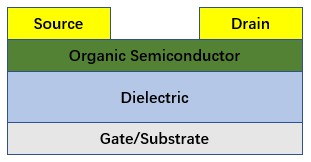Synthetic Reagents for OFET Materials
The organic field effect transistors (OFETs) have the advantages of wide source of materials, easy production, and good performance, which has a bright application prospect. The OFETs devices are composed of three terminals: source, drain, and gate, as well as organic semiconductor, dielectric channel, and gate. Figure 1 shows the structure of classical OFETs devices. OFETs synthesis reagents are mainly utilized in organic semiconductor layers and dielectric layers.
 Figure 1. The structure of classical OFETs[1].
Figure 1. The structure of classical OFETs[1].
- Organic Semiconductor
The naphthalene ring, as a larger covalent system, possesses the p co-choking effect. Among them, the derivatives represented by naphthalenetetraimide (NDI) have become the parent of many n-type semiconductor materials. Based on NDI, scholars have formed new molecules by replacing hydrogen atoms with halogen atoms on the benzene ring by synthetic reagents or by attaching different R groups on top of hydrogen atoms, and then compared the performance gap between them using test data methods. Isoindigo derivatives prepared by synthetic reagents are widely used in organic semiconductor materials. Their molecules have two internal lactam structures and also have internal connections with hydrogen bonds, thus forming a co-khorne system with strong electron deficiency. In addition, the synthesis and OFET characterization of anthracene-pentacene binary compounds is the first example of other small molecule OFETs materials with similar properties. This is the synthesis of a series of asymmetric pentacene derivatives with functionalized anthracene groups, using hydrogen H, fluorine F, chlorine Cl, and bromine Br atoms in place of anthracene at position 9, and the pentacene derivatives display bipolar behavior.
- Dielectric
Compared with inorganic dielectric materials, Organic dielectric layer prepared using synthetic reagents have the following advantages: a wide range of materials, low surface roughness, low density of surface defects, low impurity concentration, suitable for low-temperature solution processing technology, low cost. Moreover, organic dielectric materials have good compatibility with the flexible substrates of organic field effect transistors, showing great potential in flexible electronic applications. For example, A layer of poly(2,5-bis(3-alkylthiophen-2-yl)thieno[3,2-b]thiophene) (pBTTT) was coated on the dielectric surface to change the roughness, and the effect of dielectric surface roughness on the morphology, semiconductor grain size, molecular arrangement and charge transport of the semiconductor layer was investigated. When pBTTT was spin-coated onto a flat, low surface energy substrate, the dielectric surface was heated to form an intermediate phase with a more regular trapezoidal region and higher local electron mobility, and the device mobility showed a significant dependence on the dielectric surface roughness.
Application
Compared with conventional field-effect transistors, OFETs can be processed on flexible substrates by the solution method, and they are low-cost and can better meet the requirements of low consumption and light weight for future electronic devices, and thus are gradually attracting attention. Moreover, the targeted use of synthetic reagents to prepare the related OFETs materials allows the prepared OFETs to be adapted to operate under a variety of conditions such as high temperature, high pressure, and humidity. The use of hybrid organic materials as semiconductor layers or dielectric layers to improve device performance has become a hot topic of research in recent years, one step closer to successfully developing a mature, well-established commercial material. Therefore, the search for better hybrid organic materials and a simpler and more economical preparation process to obtain higher performance OFETs will become the main task in the future.
Reference
- Yan, Lei, et al. Metallopolyyne polymers containing naphthalene diimide-oligothiophene moieties and their applications in organic field-effect transistors. Journal of Organometallic Chemistry, 2017, 846: 269-276.




![ethyl 2,5-dibromo-6-nonylthieno[3,2-b]thiophene-3-carboxylate](https://resource.bocsci.com/structure/2105955-68-6.gif)

![Poly[(9,9-dioctylfluorenyl-2,7-diyl)-co-(4,4'-(N-(p-butylphenyl))diphenylamine)]](https://resource.bocsci.com/structure/223569-31-1.gif)













